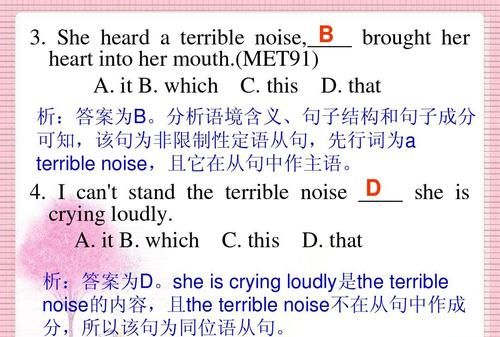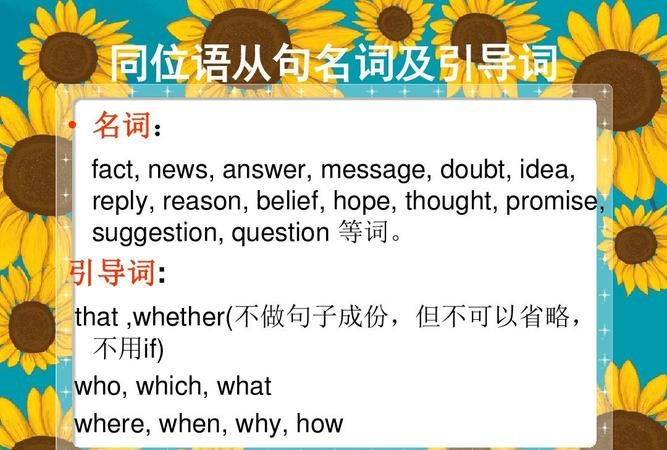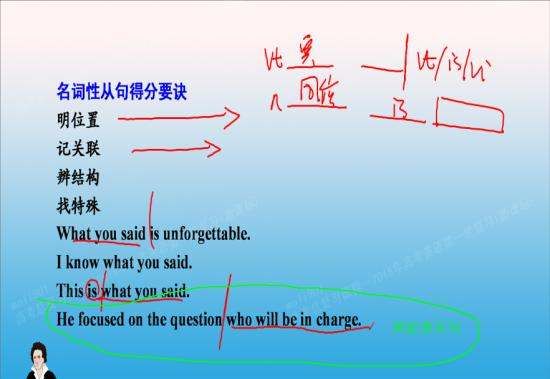本文目录
同位语从句引导词是什么
that,when,where,why。
1.引导词that
引导定语从句的that叫做关系代词,它除了起连接作用,还在定语从句中充当一定成分,并且在意义上代表先行词;引导同位语从句的that叫做从属连词,它只起连接作用。不能省略。
例如:
①The news that you told me yesterday was really exciting.
②We heard the news that our team had won.
在①句中,加粗部分是定语从句,that在从句中作宾语,在意义上指代先行词news。
在②句中,加粗部分是同位语从句,that没有任何意义,只起连接作用。
2.引导词when,where,why
引导定语从句时,它们叫做关系副词,在从句中充当状语,可以转换成"介词+关系代词"的形式;引导同位语从句时,它们叫做连接副词,在从句中充当状语,但不能转换成"介词+关系代词"的形式。
例如:
①I will never forget the day when I joined the army.
②We have no idea when she was born.
在①句中,加粗部分是定语从句,when在从句中作状语,它可以转换成on which的形式。
在②句中,加粗部分是同位语从句, when在从句中充当状语,但不能转换成"介词+关系代词"的形式。

定语从句和同位语从句区别
1.被修饰的词不同:同位语从句的前面一般是数量有限的、表示抽象意义的名词;而定语从句的先行词是无数的指人或物名词。
2.从句的作用不同:同位语从句表示同位名词的具体内容,而定语从句是对先行词的限制、描绘或说明。
3.引导词不同:what, how, whether等不能用引导定语从句,但可用于引导同位从句。
同位语从句的概念及用法总结
同位语从句属于名词性从句,大多由连词that引导,常常跟在fact, idea, opinion, news, hope, belief等名词后面.同位语从句一般用来解释或说明这些名词的具体含义或内容,在逻辑上表现为同位关系.
They are familiar with the opinion that all matter consists of atoms.
他们很熟悉这一观点,所有的物质都是由原子构成的
从先行词来看
同位语从句与名词之间该名词是需要做特殊说明的名词.idea, fact, news, hope, belief, suggestion, word, thought, doubt, truth, possibility, promise, order等有一定内涵的名词
They were delighted at the news that their team had won.
当听到他们的球队赢了的消息时,他们欣喜若狂.
定语从句与先行词---可以是名词?代词?主句的一部分或是整个主句
The factory(that)we visited yesterday is a chemical one.
2、从引导词that来看
引导词that在同位语从句中是连词,只起连接作用,无具体词义,that不可省略;
that在定语从句中是关系代词,它在从句中充当一定成分---主语或宾语,有具体词意,作宾语时还可以省略.试比较:
The factory(that)we visited yesterday is a chemical one.我们昨天参观的那家工厂是化工厂.
The news that he will leave for Shanghai is true.他将要去上海的消息是真的.
(that只起连接从句的作用,所以此句是同谓语从句)
3.从句的功能与性质
定语从句是形容词从句,其作用相当于一个形容词,对其先行词的修饰或限制;
同位语从句是名词从句,其作用相当于一个名词,对前面抽象名词的进一步的说明和解释The news that our team has won the game was true. 我们队赢了那场比赛的消息是真的?
(同位语从句,补充说明news到底是一个什么消息?)
The news that he told me yesterday was true. 昨天他告诉我的那个消息是真的?
(定语从句,news在从句中作told的宾语?)
4. 引导词在从句担当的成分
有些引导词如how, whether, what可以引导同位语从句,但不能引导定语从句?
定语从句的引导词that在从句中充当一定的成分,可作主语、宾语、
同位语从句中的引导词that在从句只起连接作用,不作任何句子成分.
1. A plane is a machine that can fly. 飞机是一种能飞的机器.
2. The fact that they didn't finish the work has to be faced. 必须面对事实他们没有完成工作.
例1中的引导词that在从句中充当句子成分,作从句的主语,故为定语从句;
例2中的that起连接作用,引导从句解释fact的内容,不作任何句子成分,为同位语从句.
5.引导词担当成分时的省略
引导定语从句的关联词在从句中作宾语或状语时,可以省略或被其他词代替;介词+which
同位语从句的引导词一般不能省略,更不能被代替.
1. The news that she heard is true. 她听到的消息是真的.
2. The news that she will go abroad is true. 她将出国这消息是真的.
例1是定语从句,that可省略;例2是同位语从句,that不能省略.
3. The reason why he was chosen is unknown. 他为什么被选上的原因还是不清楚 (定)
4. The idea why he was chosen attracted our attention.
他为什么会被选上,这一想法引起我们的注意. (同位语从句)
四、同位语从句与其所修饰的名词之间是一种同位关系,二者之间存在逻辑上的系表关系,可用“主+系+表”结构来表示.例如:
The news that he won the first place is true. 他赢得冠军的那个消息是真的.
上句若用“主+系+表”结构来表示,则是:
The news is that he won the first place. 消息是他赢得了冠军.
意思合理,系表结构成立,故为同位语从句.
五、定语从句所修饰、限定的先行词可以是各类名词,可以有复数形式;而同位语从句一般都与抽象名词同位,一般没有复数形式.
六、由when, why, where引导的定语从句分别修饰或说明表示时间、原因或地点的词,
但它们引导的同位语从句一般不和表示时间或地点的词同位.例如:
定1. I still remember the day when I first came to Beijing. 我仍然记得初次来北京的那天.
同2. I have no idea when she will be back. 我不知道她何时回来.
定3. This is the house where I lived two years ago. 这是我两年前住的房子.
同4. The question where we shall have a meeting hasn't decided. 我们到什么地方去开会,这个问题没有决定.
同位语从句:that 有些名词的后面可以接that引导的同位语从句:We came to the decision that we must act at once. 我们做出决定:我们必须立即行动.There was little hope that he would survive. 他幸存的希望很小
同位语从句:whether whether可以引导同位语从句,而定语从句不能用whether作为引导词. He hasn’t made the decision whether he will go there他还没有做出决定是否去那里. I have small doubt whether he is suitable for the job. 他是否适合这件工作我有点怀
同位语从句:what what可以引导同位语从句,而定语从句不能用what作为引导词
I have no idea what he is doing now. 我不知道他现在在干什么
同位语从句:how how可以引导同位语从句,而定语从句不能用how作为引导词
It’s a question how he did it. 那是一个他如何做了此事的问题
同位语从句: who, whom, which, when, where, why用来引导同位语从句
The question who should do the work requires consideration.
谁该干这项工作,这个问题需要考虑.
She raised the question where we could get the fund. 她提出这个问题我们到哪儿去搞这笔资
同位语从句和定语从句的区别
1同位语从句和先行词是同等的关系;而定语从句是用来修饰先行词,是从属的关系
2)that在同位语从句中没有词义,不充当句子成分;而定语从句中充当主语、宾语等成分
3)whether, what, how可以用来引导同位语从句;而它们不能用来引导定语从句.
4)一 从词义角度看问题 who, whom, which, when, where, why用来引导同位语从句是保持原来疑问词的含义;它们用来引导定语从句时,不具有疑问词的含义二 从搭配角度看问题who, whom, which, when, where, why用来引导定语从句时对应性很强,如: 先行词是“人”,引导词用“who”等,而它们引导同位语从句是先行词通常是“question, idea, doubt等

同位语从句用法
一、理解同位语从句的含义,把握同位语从句的实质
在主从复合句中作同位语的从句称为同位语从句。同位语从句一般用that,whether等词引导,常放在fact,news,idea,truth,hope,problem,information等名词后面,说明该名词的具体内容。换言之,同位语从句和所修饰的名词在内容上为同一关系。
例:The news that they had won the game soon spread over the whole school.他们比赛获胜的消息很快传遍了整个学校。
析:they had won the game说明The news的全部内容,因此该句为同位语从句。
二、正确运用同位语从句的引导词,准确把握同位语从句
1.如同位语从句意义完整,应用that引导同位语从句。
例:The general gave the order that the soldiers should cross the river at once.将军下达了战士们立即过河的命令。
析:the soldiers should cross the river at once是the order的全部内容,且意义完整,因此应用that引导同位语从句。
2.如同位语从句意义不完整,需增加"是否"的含义,应用whether引导同位语从句。
例:We'll discuss the problem whether the sports meeting will be held on time.我们将讨论运动会是否会如期举行的问题。
析:the sports meeting will be held on time意义不完整,应加"是否"的含义才能表达the problem的全部内容,因此应用whether引导同位语从句。
3.如同位语从句意义不完整,需增加"什么时候"、"什么地点"、"什么方式"等含义,应用when,where,how等词引导同位语从句。
例1:I have no idea when he will be back.
析:he will be back意义不完整,应加"什么时候"的含义才能表达idea的全部内容,因此应用when引导同位语从句。
例2:I have no impression how he went home,perhaps by bike.
析:he went home意义不完整,应加"如何"的含义才能表达impression的全部内容,因此应用how引导同位语从句。
三、把握同位语从句和定语从句的区别,明确同位语从句和相似从句的界限
同位语从句和定语从句相似,都放在某一名词或代词后面,但同位语从句不同于定语从句。同位语从句对名词加以补充说明,是名词全部内容的体现,且名词和同位语从句的引导词均不在从句中作成分;定语从句对名词加以限制,是名词内容的修饰性定语,且名词和定语从句的引导词均在从句中作成分。
例1:Information has been put forward ____ more middle school graduates will be admitted into universities.(NMET2001上海)
A.while B.that C.when D.as
析:答案为B。more middle school graduates will be admitted into universities是Information的内容,且Information不在从句中作成分,所以该句为同位语从句。应将该句区别于:
It is said that more middle school graduates will be admitted into universities,this is the information ____ has been put forward.
A.what B.that C.when D.as
析:答案为B。that has been put forward为information的修饰性定语,且information在从句中作主语,所以该句为定语从句。
例2:She heard a terrible noise,____ brought her heart into her mouth.(MET91)
A.it B.which C.this D.that
析:答案为B。分析语境含义、句子结构和句子成分可知,该句为非限制性定语从句,先行词为a terrible noise,且它在从句中作主语。应将该句区别于:
I can't stand the terrible noise ____ she is crying loudly.
A.it B.which C.this D.that
析:答案为D。she is crying loudly是the terrible noise的内容,且the terrible noise不在从句中作成分,所以该句为同位语从句。

同位语从句的引导词
同位语从句的引导词,引导同位语从句的词语通常有连词that,whether,连接代词和连接副词等。 that连接从句时从句为一个句意完整的陈述句。that不能省略,没有具体的意思,不充当句子成分,只起连接作用。
(注:引导同位语从句的that不能省略)
The idea that you can do this work well without thinking is quite wrong.你认为不动脑筋就能做好这件工作的想法是完全错误的。(作idea的同位语)
【注意1】在某些名词(如demand,wish,suggestion,resolution等)后面的同位语从句要用虚拟语气
There was a suggestion that Brown should be dropped from the team. 有一项建议是布朗应该离队。
【注意2】引导同位语从句的连词that通常不省略,但在非正式文体中也可以省去。
He grabbed his suitcase and gave the impression he was boarding the Tokyo plane. 他拿起了手提箱,给人的印象是他要登上飞往东京的飞机了。 (注:if不能引导同位语从句)
The question whether we should call in a specialist was answered by the family doctor. 我们是否请专家由家庭医生来定。
【注意】whether 可引导同位语从句,但if不能引导同位语从句。 连接代词what,who,whom,whose,引导同位语从句
1).I have no idea what size shoes she wears.我不知道她穿几号的鞋。(what作定语)2).The question who will take his place is still not clear. (who作主语) 连接副词when,where,how,why
We haven’t yet settled the question where we are going to spend our summer vacation.到哪儿去度暑假,这个问题我们还没有决定。 1.定语从句的先行词是名词或代词;而同位语从句的先行词只能是名词,而且仅限于idea,plan,fact,theory,promise,hope,news,doubt,truth,information,suggestion,question, thought,belief,conclusion等少数名词。
例如:
①The boy who is playing football is my classmate.
②Those who work hard will succeed.
③The fact that he had not said anything surprised everybody.
④The fact that you are talking about is important.
在①句中,加粗部分是定语从句,其先行词是名词 boy,是具体名词,它不能用作同位语从句的先行词。
在②句中,加粗部分也是定语从句,其先行词是代词those,代词不能用作同位语从句的先行词。
在③句中,加粗部分是同位语从句,其先行词是名词fact,它同样可以用作定语从句的先行词,④句便是一例。加粗部分是对fact的修饰,所以是定语从句。
由以上分析可见,同位语从句的先行词一定可以用作定语从句的先行词,但定语从句的先行词不一定能用作同位语从句的先行词。
2.when,where,why引导的定语从句的先行词一定分别是表示时间、地点和原因的名词,而三者引导的同位语从句的先行词则肯定不是表示时间、地点和原因的名词。
例如:
①I still remember the day when I first came to Beijing.
②I have no idea when she will be back.
在①句中,加粗部分是when引导的定语从句,其先行词day是表示时间的名词;
在②句中,加粗部分是when引导的同位语从句,其先行词idea则不是表示时间的名词。 定语从句和同位语从句共同的引导词有四个:that,when,where,why。下面把四个引导词分成两类说明它们在两种从句中的不同用法。
1.引导词that
引导定语从句的that叫做关系代词,它除了起连接作用,还在定语从句中充当一定成分,并且在意义上代表先行词;引导同位语从句的that叫做从属连词,它只起连接作用。不能省略。
例如:
①The news that you told me yesterday was really exciting.
②We heard the news that our team had won.
在①句中,加粗部分是定语从句,that在从句中作宾语,在意义上指代先行词news。
在②句中,加粗部分是同位语从句,that没有任何意义,只起连接作用。
2.引导词when,where,why
引导定语从句时,它们叫做关系副词,在从句中充当状语,可以转换成介词+关系代词的形式;引导同位语从句时,它们叫做连接副词,在从句中充当状语,但不能转换成介词+关系代词的形式。
例如:
①I will never forget the day when I joined the army.
②We have no idea when she was born.
在①句中,加粗部分是定语从句,when在从句中作状语,它可以转换成on which的形式;
在②句中,加粗部分是同位语从句, when在从句中充当状语,但不能转换成介词+关系代词的形式。
③This is the house where I lived two years ago.
④He put forward to the question where the meeting would be held.
在③句中,加粗部分是定语从句,where在从句中作状语,它可以转换成in which的形式;
在④句中,加粗部分是同位语从句, where在从句中充当状语,但不能转换成介词+关系代词的形式。
⑤This is the reason why she will not attend the meeting.
⑥The teacher had no idea why Jack was absent.
在⑤句中,加粗部分是定语从句,why在从句中作状语,它可以转换成for which的形式;
在⑥句 中,加粗部分是同位语从句,why在从句中充当状语,但不能转换成介词+关系代词的形式。

以上就是关于同位语从句引导词的用法 ,同位语从句的概念和用法的全部内容,以及同位语从句引导词的用法 的相关内容,希望能够帮到您。
